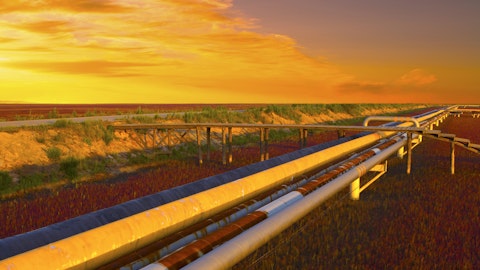So those growth numbers really work on both the BOE and the ball of oil basis. And we can get some noise on mix from quarter-to-quarter in the Lower 48, depending which particular pads are brought online across our basins, but that will average out over the year to a consistent product mix. So for example, if you look at our second half 2022 compared to first half of this year, we’ve had very consistent product mix in Lower 48, around 54% oil. So yes, we’re pleased with the production progress. Like I said, really the Permian and the low 48 is driving that. So Nick, do you want to talk a little bit about that?
Nicholas Olds: Yes. Thanks, Dominic. Yes. So there are probably 2 main reasons for that driver for the top end of the range on Lower 48. First, we had modest accelerations of activity kind of late Q1 and 2Q, therefore, accelerating some wells online and then strong well performance. Now the accelerations that I mentioned was resulting of improved drilling and completion efficiency. So as I mentioned at the Analyst and Investor Meeting, we continue to realize improved efficiencies in 2023, therefore, accelerating some of the wells. So that’s point #1. And then if you look at the overall strong well performance, we’re seeing that across the board. So we’re either at 2022 performance or exceeding our type curves in certain areas as well.
So that’s, as Dominic mentioned, very encouraging I will point out a couple of points on the drilling and completion efficiency that’s making a large difference. We continue to realize efficiency improvements, for example, in our Permian real-time Drilling Intelligence Group, where, Neil, we have 24/7 real-time monitoring where we can optimize the rig program, we can troubleshoot across the entire Permian rig fleet and then share best practices across the rigs as well. That’s resulting in 10% improvement in ROP. And then we continue to high-grade rigs across the Lower 48 to drive and improve operational efficiency. And then on the fracking side, simul frac, remote frac, and we’re testing out some new technology down in the Eagle Ford continue to drive efficiency.
So very encouraging.
Operator: Our next question comes from the line of Steve Richardson with Evercore ISI.
Stephen Richardson: I was wondering if you could talk a little bit about the Mexico-Pacific offtake agreement. Conceivably, you have a lot of — looking at these types of deals. So why was this the right project for you? And also, what do you see the path to sort of FID and timing there? I would love to hear a little bit more about that and how it fits in the broader strategy.
Ryan Lance: Well, maybe, Steve, I’ll take some of the broader strategy and then turn specifically over to Bill for the Saguaro project itself. But as we try to lay out a game kind of looking at a high level, we think from a energy transition perspective and just confidence in what we’re really good at on the LNG side, we wanted to expand that piece of our business. So we set out a couple of years ago to go do that. I think it’s consistent with the Qatari volumes. Of course, getting Port Arthur to FID and then and now the Saguaro opportunity, specifically on the West Coast. But it’s all in service to trying to build up more — a bigger LNG business inside the company and taking opportunities as they become available, both on the equity side at Port Arthur but, more importantly, on the offtake side in trying to service some of the growing demand that we see coming out of Europe and Asia. I can have Bill — Bill can talk more specifically about the Saguaro project.
William Bullock: Yes, sure. So as we talked at AIM, we’re really focused on building up both our market and our originating highly competitive supply on a pretty stair-step basis. And we’re making excellent progress on both those fronts, Steve. So as Ryan mentioned, we’ve secured million tons of regas in Germany. That supports our 2 million-ton offtake from our LNG SPAs with Qatar. That leaves 0.8 for our commercial LNG business. And putting that in perspective, that’s 16% of Port Arthur LNG right there. And we are continuing to make excellent progress advancing offtake into Europe, and we’ve been progressing discussions with several Asian buyers. Really happy and pleased with how we’re moving forward with developing market.





